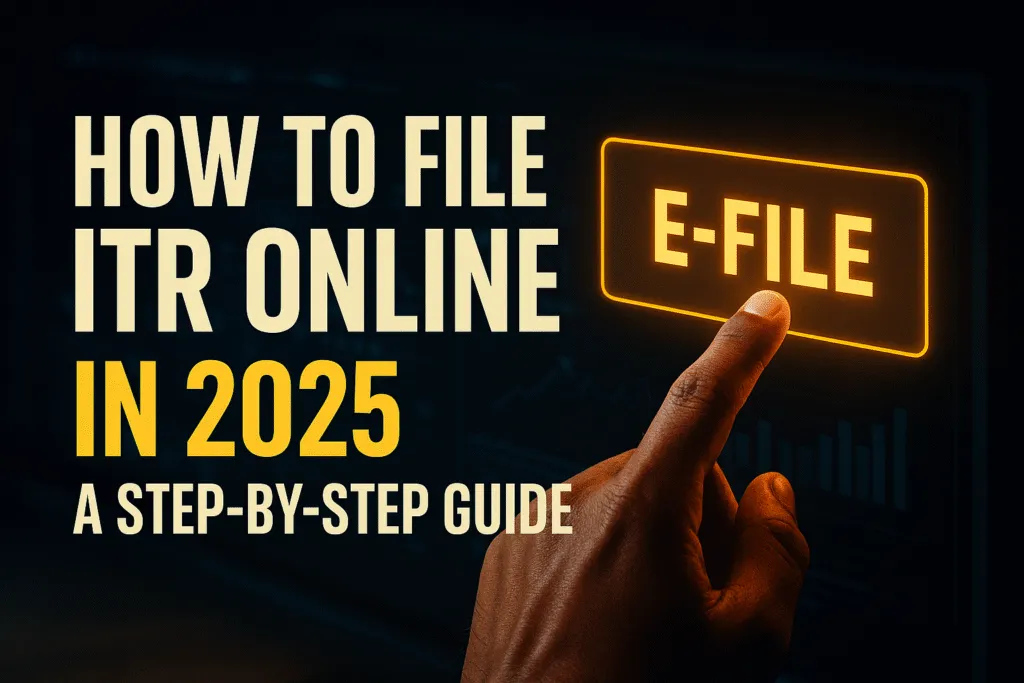Introduction: Why Filing ITR Matters
Filing Income Tax Returns (ITR) is more than just a yearly formality—it’s an essential part of being a responsible citizen. Many people, especially first-time earners or freelancers in the tech space, often wonder why it’s even necessary. The answer lies in the long-term benefits and legal compliance that come with it. Whether you’re a salaried professional, a startup founder, or a content creator earning from multiple platforms, you should always file ITR online if your income crosses the basic exemption limit.
Filing ITR builds your financial credibility. It acts as documented proof of your income, which can be extremely helpful when applying for loans, credit cards, or even a visa. Even if your income is below the taxable limit, filing returns voluntarily can be advantageous in the future.
Another major reason to file ITR online is to claim refunds. If TDS (Tax Deducted at Source) has been deducted on your income but your total taxable amount is lower, you can get that excess amount refunded—only if you file your return. Also, timely filing helps you avoid penalties and late fees imposed by the Income Tax Department.
As someone working in the digital or tech ecosystem, your income sources might be diverse—ad revenue, freelance gigs, affiliate marketing, or even crypto. In such cases, it becomes all the more important to stay compliant and file ITR online accurately.
In the long run, consistent filing not only keeps you on the right side of the law but also makes your financial journey smoother. It’s not just about paying taxes—it’s about being in control of your earnings, benefits, and future opportunities.
Who Needs to File Income Tax Returns in India?
Understanding who should file ITR online is the first step toward staying compliant with tax laws in India. While not everyone is required to file returns, certain income thresholds and financial activities make it mandatory for many individuals.
If you are an individual below the age of 60 and your total annual income exceeds ₹2.5 lakh, you must file ITR online. For senior citizens aged between 60 and 80, the limit is ₹3 lakh, and for super senior citizens (80+), it’s ₹5 lakh. Even if your income is tax-exempt under various deductions or rebates, you are still required to file if your gross income before deductions crosses these limits.
But income isn’t the only trigger. If you own foreign assets, earn from foreign sources, or have deposited more than ₹1 crore in a current account in a financial year, filing an ITR becomes compulsory. Similarly, if you’ve spent ₹2 lakh or more on foreign travel or paid ₹1 lakh or more in electricity bills in a year, you are required to file ITR online regardless of your income level.
Business owners, freelancers, and gig workers—especially in the tech and digital space—should also pay close attention. Even if your income is irregular or comes from multiple sources, once it crosses the basic exemption limit, filing returns is mandatory.
Additionally, those who want to claim tax refunds, carry forward losses, or apply for loans and visas should file ITR online, even if their income is below the taxable threshold. It’s not just a tax rule—it’s a smart financial habit.
In short, if you’re earning and growing financially in any capacity, understanding your obligation to file ITR online is a must to avoid legal trouble and unlock various benefits.
Documents Required Before You Start
Before you file ITR online, it’s crucial to gather all the necessary documents to ensure a smooth and error-free process. Having the right paperwork ready can save you from last-minute confusion, delays, and incorrect entries that might trigger unwanted scrutiny from the tax department.
The first and most important document is your PAN card, which acts as your identity for all tax-related matters. Along with that, your Aadhaar card is also mandatory, as it needs to be linked with your PAN and used for verification.
Next, you’ll need your Form 16, which is issued by your employer. This document contains details of your salary and the TDS (Tax Deducted at Source) deducted during the year. If you’ve changed jobs during the financial year, make sure to collect Form 16 from all employers.
If you’re a freelancer, tech consultant, or content creator, you won’t have Form 16. Instead, collect invoices, payment proofs, and bank statements to report your income accurately.
You should also download Form 26AS and the Annual Information Statement (AIS) from the Income Tax portal. These forms reflect your income, TDS, and other financial transactions reported to the tax department. Always cross-check these with your own records.
Don’t forget to collect investment proofs for deductions under sections like 80C (LIC, PPF, ELSS), 80D (health insurance), and others. Details of home loans, education loans, or donations are also essential if you plan to claim tax benefits.
If you’ve earned interest from savings accounts, FDs, or dividends, make sure to include those details too. Lastly, have your bank account details ready, as they are needed for refund processing and verification.
Getting these documents in order will make it much easier to file ITR online accurately and efficiently.
Choosing the Right ITR Form
Selecting the correct ITR form is one of the most crucial steps when you file ITR online. Using the wrong form can lead to your return being marked as defective or even rejected by the Income Tax Department. The form you choose depends on your income sources, residential status, and financial activities during the year.
For most salaried individuals or pensioners with income up to ₹50 lakh and income from interest or one house property, ITR-1 (Sahaj) is the right choice. It’s the simplest form and widely used by middle-income earners.
If your total income is above ₹50 lakh or you have income from multiple house properties, capital gains, or foreign assets, ITR-2 is more appropriate. It’s commonly used by professionals, investors, and NRIs who don’t have business income.
Freelancers, consultants, and small business owners who opt for the presumptive taxation scheme under sections 44AD, 44ADA, or 44AE should go for ITR-4 (Sugam). This form allows you to declare income on a presumptive basis, simplifying the process.
However, if you’re running a full-fledged business or involved in professions not covered under the presumptive scheme, you’ll need to file using ITR-3, which is more detailed and requires balance sheets and profit/loss statements.
Choosing the right form helps ensure accurate reporting and smooth processing. If you’re unsure, the income tax portal has a utility that auto-suggests the right form based on your input. Still, it’s always better to review the form description carefully before you file ITR online.
Using the correct ITR form is not just about compliance—it’s about presenting your financial details in a format that the system can process effectively, reducing the risk of delays or notices.
Old vs New Tax Regime: What to Choose While Filing
One of the most important decisions you’ll make when you file ITR online is choosing between the old tax regime and the new tax regime. Both offer different tax benefits, and the best choice depends entirely on your income structure, deductions, and financial goals.
The old tax regime allows you to claim various deductions and exemptions such as Section 80C (investments in PPF, ELSS, LIC), 80D (health insurance premiums), HRA, LTA, home loan interest, and more. If you have significant tax-saving investments or expenses, the old regime may reduce your taxable income considerably.
On the other hand, the new tax regime, introduced in FY 2020–21, offers lower tax rates but removes most exemptions and deductions. It is ideal for those who prefer a simplified structure or do not invest much in tax-saving instruments. The new regime is beneficial for salaried individuals or freelancers who have minimal deductions to claim.
Here’s a quick comparison:
- Old Regime: Higher tax rates, but allows you to claim deductions
- New Regime: Lower tax rates, but no major deductions allowed
When you file ITR online for AY 2025–26, salaried taxpayers can easily compare both regimes using calculators available on the portal. The regime you choose must be clearly indicated while filing, and once filed, it cannot be changed for that assessment year.
It’s not a one-size-fits-all choice. Analyze your total income, eligible deductions, and future financial plans before selecting the right regime. Taking a few minutes to compare both options can lead to significant tax savings and smarter financial planning in the long run.
Step-by-Step Guide to File ITR Online on Income Tax Portal (2025)
Filing your income tax return doesn’t have to be a stressful task. Thanks to the upgraded Income Tax e-filing portal, you can now file ITR online from the comfort of your home in a few easy steps. Whether you’re a salaried individual, freelancer, or small business owner, this guide will walk you through the entire process with clarity and ease.
Here’s how to file ITR online, step-by-step:
1. Create or Login to Your Income Tax Portal Account
To get started, visit the official Income Tax e-filing portal: https://www.incometax.gov.in. If you’re a first-time filer, you need to register using your PAN, mobile number, and email ID. If you already have an account, simply log in using your user ID (PAN), password, and the captcha code.
Make sure your PAN is linked to your Aadhaar before proceeding. Without this, you won’t be able to file ITR online successfully.
2. Select the Assessment Year & Filing Type
After logging in, click on “e-File” > “Income Tax Return” from the top menu. Choose the correct Assessment Year (for income earned in FY 2024–25, the AY will be 2025–26). Then, select the mode as Online and choose the applicable status: Individual, HUF, or others.
This step ensures you’re filing for the right period and under the right category, avoiding technical errors.
3. Choose the Applicable ITR Form
Based on your income sources and category, the portal may suggest the suitable ITR form. You can also select it manually. Here’s a quick reference:
- ITR-1: For salaried individuals with income up to ₹50 lakh
- ITR-2: For those with capital gains or foreign income
- ITR-3: For business/professional income
- ITR-4: For presumptive income (freelancers, small businesses)
Choosing the right form is critical to file ITR online without facing rejection or notices.
4. Prefill & Validate Your Details
Once inside the form, the portal will prefill many details using your PAN, Aadhaar, and AIS/Form 26AS data. This may include:
- Basic personal information
- Bank details
- Salary or interest income
- TDS details
Review all prefilled fields carefully. If anything looks incorrect, update it manually and cross-verify with your documents.
5. Add Income Details
Now comes the core part of filing your ITR online—reporting all your income sources:
- Salary: Use Form 16 to fill in your salary structure and TDS
- Other Income: Interest from savings account, FDs, dividends, etc.
- House Property: Rental income, home loan interest, etc.
- Capital Gains: From stocks, mutual funds, real estate, etc.
- Business or Freelance Income: Include invoices, turnover, and expenses
Ensure complete and honest disclosure. Misreporting or underreporting income can lead to penalties or notices from the tax department.
6. Claim Deductions (80C, 80D, etc.)
This is where you reduce your taxable income legally. Under the old tax regime, you can claim deductions like:
- 80C: Investments in PPF, ELSS, LIC, PF, tuition fees
- 80D: Health insurance premiums
- 80G: Donations to registered charities
- 80E: Education loan interest
- 24(b): Home loan interest
Enter all eligible deductions carefully. If you opted for the new tax regime, most deductions won’t be applicable.
Always double-check against your investment proofs before you file ITR online.
7. Preview Your ITR Form
Before final submission, click on “Preview” to review the complete return. Make sure:
- All income details are correctly entered
- No deductions are missed
- TDS and advance tax payments are correctly reflected
- Your bank account for refund is mentioned and verified
Errors caught at this stage can save you from rectifications or notices later. If anything seems off, go back and edit accordingly.
8. Submit and E-Verify
Once satisfied, proceed to submit your ITR. But you’re not done yet—you must verify your return for it to be considered valid.
The easiest and fastest way to e-verify is using Aadhaar OTP or net banking. Other options include:
- Demat account verification
- Bank account EVC
- Sending a signed physical ITR-V to CPC, Bengaluru (if digital options fail)
Make sure you complete this step within 30 days of submission. Without e-verification, your return will be treated as invalid, even if you file ITR online on time.
Final Thoughts
The process to file ITR online has become more streamlined and user-friendly, especially with the new portal’s intelligent features. Still, it’s important to understand each step to avoid common mistakes. Filing your ITR not only keeps you compliant with the law but also builds your financial reputation, helps in visa applications, and ensures smooth loan processing.
If you earn income—whether through a job, freelance projects, or investments—filing your return is not optional. It’s a smart financial move that secures your future and keeps you legally protected.
Take time to file ITR online properly, and if needed, consult a tax expert or use trusted filing platforms for added accuracy.
Common Mistakes to Avoid While Filing ITR
Filing your income tax return may seem simple, especially with the option to file ITR online, but even a small mistake can lead to penalties, notices, or refund delays. Many taxpayers, especially first-timers, often overlook basic yet crucial details. Here are the most common mistakes you should avoid while filing your ITR online:
1. Selecting the Wrong ITR Form
One of the most frequent errors is choosing an incorrect ITR form. Each form is designed for specific income categories. Filing under the wrong one can make your return defective or even invalid. Always review which ITR form suits your income type before proceeding.
2. Not Reporting All Income Sources
Many individuals forget to include income from savings account interest, freelance gigs, rental income, or capital gains. The Income Tax Department can track these through Form 26AS and AIS, so it’s important to report everything, even if the amount is small.
3. Ignoring Form 26AS and AIS
These two documents are crucial while you file ITR online. They show the taxes already deducted (TDS) and other financial transactions reported to the tax department. Mismatches between your return and these records can lead to scrutiny.
4. Claiming Incorrect or Ineligible Deductions
Some taxpayers claim deductions they are not eligible for or make calculation mistakes while entering 80C, 80D, or HRA exemptions. This can lead to rejection of the return or penalties. Always cross-check with investment proofs and deduction limits.
5. Forgetting to E-Verify the Return
Submitting your return is only half the process. If you don’t e-verify your return within 30 days, it will be considered invalid. Choose the Aadhaar OTP or net banking option to complete this step instantly.
6. Using Incorrect Bank Account Details
If your bank account number or IFSC code is wrong, any refund due may fail to credit. Always double-check these details and ensure your account is pre-validated on the portal.
7. Filing After the Deadline
Missing the due date not only attracts late fees under Section 234F but also disqualifies you from carrying forward certain losses. Make it a point to file ITR online well before the deadline to avoid last-minute rush.
8. Not Disclosing Foreign Assets or Crypto Income
If you own foreign bank accounts or earn through cryptocurrencies, it is mandatory to report them in your ITR. Hiding such income can result in serious legal consequences, including heavy penalties.
9. Overlooking Advance Tax or Self-Assessment Tax
If you have income from business, capital gains, or interest that is not covered by TDS, you may be liable to pay advance tax. Many skip this and end up with interest liabilities under Sections 234B and 234C.
10. Copy-Pasting Previous Year’s Data Without Review
Each financial year is different. Auto-filled data can help, but blindly copying last year’s return can cause mismatches if your income or deductions have changed.
Avoiding these common pitfalls will help you file ITR online smoothly and ensure faster processing and refunds. Take your time, verify each section, and if you’re unsure, seek help from a tax professional to stay compliant and stress-free.
ITR Filing Deadlines for AY 2025–26
If you’re planning to file ITR online for the Assessment Year 2025–26, it’s important to stay updated with the latest deadlines to avoid penalties and interest. The Central Board of Direct Taxes (CBDT) has extended the due date for non-audit taxpayers this year, giving individuals some extra time to complete their returns.
Updated ITR Filing Deadlines for AY 2025–26:
- For individuals and HUFs not requiring audit:
Extended deadline – September 15, 2025
(Original deadline was July 31, 2025) - For taxpayers requiring audit (under Section 44AB):
Deadline – October 31, 2025 - For entities involved in transfer pricing (international/domestic transactions):
Deadline – November 30, 2025 - For filing belated or revised return:
Deadline – December 31, 2025 - For filing updated return (ITR-U):
Deadline – March 31, 2028
(Applicable up to 3 years from the end of the relevant assessment year)
Important Points to Remember:
- No late fee or interest will be charged under Sections 234F or 234A if you file ITR online by the new deadline of September 15, 2025.
- Filing after this date may attract a late fee of up to ₹5,000, depending on your income level.
- If you miss the extended deadline, you can still file a belated return by December 31, 2025, but with penalties and possibly interest.
- Always verify your return within 30 days of submission. Failing to e-verify will render your return invalid.
- The earlier you file, the faster you can receive your refund, if eligible.
Meeting the official deadlines ensures a smooth filing experience and keeps you financially disciplined. If you’re eligible, it’s wise to file ITR online early and avoid the last-minute rush.
What Happens After Filing: Refunds, Notices & Processing
Once you file ITR online and complete e-verification, the process isn’t over just yet. There’s a sequence of actions that the Income Tax Department carries out behind the scenes to verify your return, issue refunds (if any), and handle discrepancies, if found. Understanding what happens after filing can help you stay informed and avoid confusion.
1. E-Verification Confirmation
After submission, your return must be e-verified—either instantly via Aadhaar OTP, net banking, or through other available methods. Only after successful e-verification is your ITR considered valid and ready for processing. You’ll receive an acknowledgment (ITR-V) on your registered email ID.
2. ITR Processing by CPC
Your return is processed by the Centralized Processing Centre (CPC) of the Income Tax Department in Bengaluru. The system automatically matches the data you provided with information from:
- Form 26AS
- AIS (Annual Information Statement)
- TDS records
- Your PAN-linked transactions
If everything checks out, the ITR is marked as “Processed” under Section 143(1).
3. Refunds (If Applicable)
If excess tax has been paid (via TDS or advance tax), the system calculates the refund amount and initiates a direct transfer to your bank account. This is why it’s critical to validate your bank account on the portal before you file ITR online.
Refunds are usually processed within 7 to 45 days, depending on the volume of filings and verification time. You can track the refund status under the “My Account” section of the income tax portal.
4. Notices and Communication
If discrepancies are found, you may receive a notice under various sections:
- Section 139(9): Defective return
- Section 143(1): Intimation regarding tax calculation mismatch
- Section 143(2): Scrutiny notice (less common, selected cases)
These notices will be sent via email and also available in your portal dashboard. Always respond within the mentioned time to avoid penalties or reassessments.
5. Rectification or Revised Return (If Needed)
If you discover a mistake after filing—like incorrect income declaration or missed deductions—you can revise your return before December 31, 2025. Alternatively, if the error is from the department’s side, you can file a rectification request under Section 154.
6. Final Intimation
Once everything is processed and matched, you’ll receive a final intimation under Section 143(1), confirming:
- No demand, no refund
- Refund determined and issued
- Additional tax payable (if miscalculated)
This intimation officially closes the assessment unless your return is selected for detailed scrutiny.
In Short:
Filing your ITR online is just step one. E-verification, refund tracking, and staying alert for any notices are essential to complete the cycle. Keeping your documents ready, responding promptly, and monitoring your account regularly ensures peace of mind and tax compliance.
Conclusion: File Early, File Smart
Filing your income tax return is not just a legal obligation—it’s a smart financial habit that pays off in more ways than one. Whether you’re a salaried employee, freelancer, or small business owner, taking the time to file ITR online ensures you’re in control of your finances and future.
Filing early gives you several advantages. It helps you avoid last-minute technical glitches, allows more time to review and correct errors, and ensures faster processing of refunds. It also keeps you clear of penalties, interest charges, and unnecessary stress. When you file ITR online in a timely and accurate manner, you demonstrate financial discipline and build a clean tax history, which is useful when applying for loans, credit cards, or even visas.
Additionally, with the income tax portal offering a user-friendly interface, pre-filled data, and guided steps, the process is more accessible than ever before. But that doesn’t mean you should rush through it. Instead, plan ahead, gather your documents, choose the correct ITR form, and verify every detail carefully.
Don’t wait for the deadline to creep up. The earlier you file, the smoother the experience. And if your income is below the taxable limit, filing voluntarily still helps in creating a record of your earnings, which can be useful later.
So, whether it’s your first return or your tenth, make it a habit to file ITR online with clarity, accuracy, and timeliness. It’s not just about compliance—it’s about being proactive, responsible, and financially wise.
Also Read: 2025 Income Tax Mastery: The Essential Guide for Every Indian Earner
FAQs: Filing ITR Online in 2025
Q1. Is it mandatory to file ITR if my income is below ₹2.5 lakh?
No, if your total income is below the basic exemption limit (₹2.5 lakh for individuals under 60), filing ITR is not mandatory. However, you may still want to file ITR online to claim TDS refunds, carry forward losses, or build financial credibility.
Q2. What is the last date to file ITR for AY 2025–26?
The extended due date for filing ITR for AY 2025–26 (for individuals not requiring audit) is September 15, 2025. Belated returns can be filed till December 31, 2025, but with penalties.
Q3. Can I file ITR without Form 16?
Yes, you can file ITR online even without Form 16. Use your salary slips, bank statements, and Form 26AS to calculate your income and TDS details accurately.
Q4. Which ITR form should I use for freelance income?
If you’re a freelancer and want to declare income under presumptive taxation, use ITR-4. If your income is regular and not under the presumptive scheme, use ITR-3.
Q5. What happens if I miss the ITR deadline?
If you miss the deadline, you can still file a belated return by December 31, 2025, but you may face a late filing fee under Section 234F and lose the ability to carry forward certain losses.
Q6. Is e-verification necessary after filing ITR?
Yes, e-verification is mandatory within 30 days of filing. Without e-verification, your return is treated as invalid. You can verify using Aadhaar OTP, net banking, bank account, or other methods.
Q7. How long does it take to get an income tax refund?
If everything is in order, refunds are usually processed within 7 to 45 days after successful e-verification. You can track the refund status on the income tax portal.
Q8. Can I revise my ITR after submission?
Yes, if you notice an error after filing, you can revise your ITR online any time before December 31, 2025, for AY 2025–26.
Q9. Do I need to attach any documents while filing ITR online?
No physical documents need to be attached while filing. However, you should keep all supporting documents (like Form 16, proofs of deductions, etc.) for your own records and in case the tax department asks for them.
Q10. Is it safe to file ITR online by myself?
Yes, the income tax portal is secure and designed for self-filing. However, if your income is complex or you’re unsure about any step, consider consulting a tax expert to file ITR online accurately.













